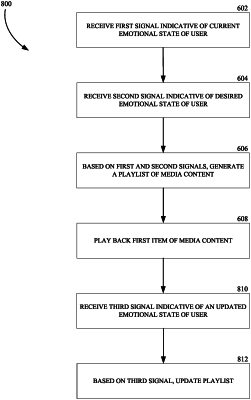| CPC G06F 3/165 (2013.01) [G05B 15/02 (2013.01)] | 20 Claims |

|
1. A system comprising:
one or more processors; and
one or more computer-readable media storing instructions that, when executed by the one or more processors, cause the one or more processors to perform operations comprising:
obtaining, via a calibration process, sensor data corresponding to a neutral mental state of a user;
generating, based on the sensor data corresponding to the neutral mental state of the user, a user-specific mental state classification;
receiving a first signal from a sensor, the first signal being indicative of a current mental state of the user;
receiving a second signal corresponding to a desired mental state, the desired mental state differing from the current mental state;
based on the user-specific mental state classification and the first and second signals, generating a playlist that includes at least (i) a first item of media content having a first parameter corresponding to the current mental state, (ii) a second item of media content having a second parameter different than the first parameter, and (iii) an nth item of media content having an nth parameter corresponding to the desired mental state, wherein the media content transitions from the first item toward the nth item;
playing one or more items of media content based on the generated playlist;
receiving a third signal indicative of an updated mental state of the user; and
dynamically updating the generated playlist, based on the received third signal indicative of the updated mental state of the user, to include one or more different items of media content than that of the generated playlist.
|